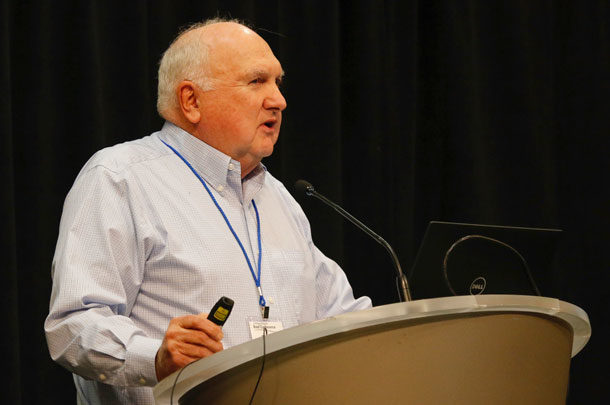During the Driftless Region Beef Conference held in Dubuque, Iowa, on Jan. 24-25, producers were not only given tips to improve their bottom line, but were also challenged to change their mindset because profitability may not be as distant as one might think.
Kicking off the conference was Burke Teichert, retired vice president and general manager with AgReserves Inc. and now a recognized consultant and speaker. He told producers first and foremost they should understand that agriculture is a science and ranching is a business, and in that agribusiness, there are four areas that need to be managed: production, economics and finance, people and marketing.
“We tend to fall in love with production,” Teichert said. “That’s what excites us. There is nothing more satisfying than nice cattle, a good crop and beautiful pastures, but we have to address finance [as well as these other areas] or we don’t get to stay in this business.”
To some extent, all areas need to be managed simultaneously, Teichert said. Too much focus in one area could negatively impact another.
As an example, Teichert reminded producers about the opportunities sitting idle in marketing. “I am convinced, in the cattle business, we do a good job of marketing our major commodity [steer calves], but do a poor job in marketing the rest of our livestock. I am quite sure that we often leave 50 to 200 dollars per head on the table with many of the other livestock we sell,” he said. “Most of us can do better in marketing.”
Feed waste
According to Alfredo DiCostanzo, a professor of beef cattle nutrition and management at the University of Minnesota, reducing feed waste in both cow-calf and feedlot operations is a low-hanging fruit when it comes to improving profitability.
Trampled-on hay, unprotected or improper storage, loss during ingredient loading in TMR mixers and feed predations by birds and rodents all come at a cost – a rising cost. Using Minnesota data from 1993 to 2017, DiCostanzo explained the impact of 10 percent waste went from $20 per cow per year to $40 per cow per year.
“With the rise in commodity prices, 10 percent waste used to mean less money than it does today. We all think 10 percent waste is ‘OK,’ but I don’t think it is anymore. Are you okay with giving up 40 dollars just like that?” he asked.
Using the same database, DiCostanzo looked at the cost of feeding mineral, and in Minnesota specifically, producers are spending an increased $45 to $50 per head per year. “Should we be buying that much mineral?” he asked. “I think it’s way too much because I can calculate something that could probably cost you 20 dollars.”
Depreciation and overheads
An important topic, depreciation and its effect on ranching operations, was addressed in two separate presentations. Teichert, being one of the presenters, told producers if they want to go from “annual money losers to annual profit makers,” they have to assess their overhead costs.
“We fall in love with stuff,” Teichert said. “We’ve got to have some of this ‘stuff’ if we want to get our work done, but we need to become selective. It’s one of our human weaknesses, and it’s one of our key [profitability] issues. Make sure you really need it in order to operate.”
Teichert noted that producers could stack a new enterprise (i.e., sheep with cattle) on top of another with little increase in overheads. Also, changing the calving season and reducing fed feed and other costs associated with winter calving can reduce the need for facilities, equipment and labor – all reducing depreciation and overhead costs, he said.
To further illustrate, Amanda Cauffman, an agricultural educator with the University of Wisconsin, compared the bottom 20 percent of farms and the top 20 percent using the University of Minnesota’s Center of Farm Financial Management’s FINBIN. The information revealed that having fewer cows in the herd impacted the effect the overhead cost had on the business. Or in other words, fewer cows meant fewer calves to spread out the overhead costs and vice versa.
“Cows do not handle a lot of overhead costs well,” Cauffman said. “We need to strive to be better than average. We need to know our numbers and what our overhead costs are so we know what to strive for to make a profit. Average isn’t going to cut it anymore.” ![]()

Cassidy Woolsey
- Editor
- Progressive Cattleman
- Email Cassidy Woolsey
PHOTO: Burke Teichert speaks to producers at the Driftless Beef Conference in Dubuque, Iowa. Staff photo.










